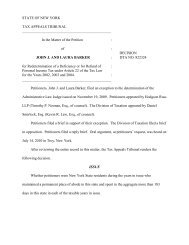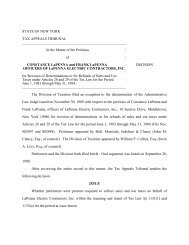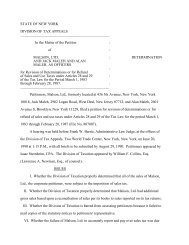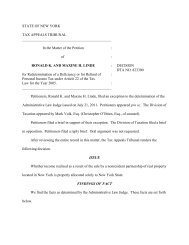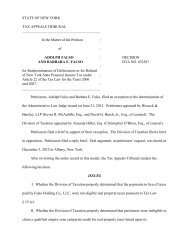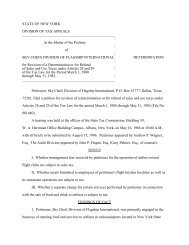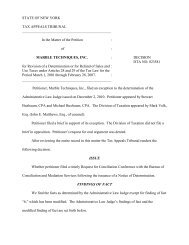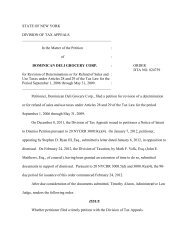John and Janine Zanetti - Tax Appeals Tribunal
John and Janine Zanetti - Tax Appeals Tribunal
John and Janine Zanetti - Tax Appeals Tribunal
You also want an ePaper? Increase the reach of your titles
YUMPU automatically turns print PDFs into web optimized ePapers that Google loves.
STATE OF NEW YORK<br />
DIVISION OF TAX APPEALS<br />
________________________________________________<br />
In the Matter of the Petition :<br />
of :<br />
JOHN AND JANINE ZANETTI : DETERMINATION<br />
DTA NO. 824337<br />
for Redetermination of a Deficiency or for Refund of New :<br />
York State Personal Income <strong>Tax</strong> under Article 22 of the<br />
<strong>Tax</strong> Law for the Years 2005 <strong>and</strong> 2006. :<br />
________________________________________________<br />
Petitioners, <strong>John</strong> <strong>and</strong> <strong>Janine</strong> <strong>Zanetti</strong>, filed a petition for redetermination of a deficiency or<br />
for refund of New York State personal income tax under Article 22 of the <strong>Tax</strong> Law for the years<br />
2005 <strong>and</strong> 2006.<br />
On August 12, 2012 <strong>and</strong> September 17, 2012, petitioners, appearing by Ronald Krieger,<br />
Esq., <strong>and</strong> the Division of <strong>Tax</strong>ation, appearing by Am<strong>and</strong>a Hiller, Esq. (Michelle M. Helm, Esq.,<br />
of counsel), waived a hearing <strong>and</strong> agreed to submit the matter for determination based on<br />
documents <strong>and</strong> briefs submitted by December 28, 2012, which date commenced the six-month<br />
period for the issuance of this determination. After review of the documents <strong>and</strong> arguments<br />
submitted, Herbert M. Friedman, Jr., Administrative Law Judge, renders the following<br />
determination.<br />
ISSUES<br />
I. Whether petitioners have shown that they were not present in New York State for more<br />
than 183 days during 2006 <strong>and</strong> therefore not taxable as resident individuals for that year pursuant<br />
to <strong>Tax</strong> Law § 605(b)(1)(B).
-2-<br />
II. Whether petitioners have shown that penalties imposed herein pursuant to <strong>Tax</strong> Law<br />
§ 685(b) should be abated.<br />
FINDINGS OF FACT 1<br />
1. Petitioners, <strong>John</strong> <strong>and</strong> <strong>Janine</strong> <strong>Zanetti</strong>, filed joint New York State nonresident income tax<br />
2<br />
returns (Form IT-203) for the 2005 <strong>and</strong> 2006 tax years. Both returns indicated petitioners’<br />
residence as Delray Beach, Florida, where they maintained a permanent place of abode. During<br />
these years, petitioners also maintained a permanent place of abode in Manhasset, New York.<br />
Nevertheless, petitioners denied on their 2006 New York State return that they maintained living<br />
quarters in New York State.<br />
2. On June 11, 2010, following an audit, the Division of <strong>Tax</strong>ation (Division) issued to<br />
petitioners Notice of Deficiency number L-034104598, which asserted additional New York<br />
State personal income tax due of $95,002.00 for the year 2005 <strong>and</strong> $134,640.00 for the year<br />
2006. The Division determined that petitioners were liable for the additional tax as they<br />
maintained a permanent place of abode <strong>and</strong> spent in excess of 183 days in New York State in<br />
each of 2005 <strong>and</strong> 2006 <strong>and</strong>, therefore, were statutory residents pursuant to <strong>Tax</strong> Law<br />
§ 605(b)(1)(B). The Notice of Deficiency also asserted interest <strong>and</strong> penalties for negligence<br />
pursuant to <strong>Tax</strong> Law § 685(b) for each tax year.<br />
3. Pursuant to a Conciliation Order dated February 11, 2011 <strong>and</strong> issued by the Division’s<br />
Bureau of Conciliation <strong>and</strong> Mediation Services, petitioner’s 2005 New York State income tax<br />
1<br />
On October 10, 2008, the parties entered into a written stipulation of facts, the relevant portions of which<br />
have been incorporated into the following Findings of Fact.<br />
2<br />
Petitioner <strong>Janine</strong> <strong>Zanetti</strong>’s name appears herein by virtue of having filed joint federal <strong>and</strong> New York State<br />
personal income tax returns with her husb<strong>and</strong>, petitioner <strong>John</strong> <strong>Zanetti</strong>. Unless specified or required by context,<br />
references using the singular term “petitioner” shall mean petitioner <strong>John</strong> <strong>Zanetti</strong>.
-3-<br />
deficiency was canceled. The statutory notice, including penalties, however, was sustained with<br />
regard to the deficiency for 2006.<br />
4. The parties agree that petitioner spent 172 complete days outside of New York State in<br />
2006. They also agree that petitioner was in New York State for 167 days.<br />
5. There are 26 other days in 2006 that are in dispute in this matter. They are January 2<br />
<strong>and</strong> 15; February 4, 17, <strong>and</strong> 22; March 1, 10, 17, <strong>and</strong> 26; April 7 <strong>and</strong> 16; May 2 <strong>and</strong> 14; June 1,<br />
10, 14, <strong>and</strong> 18; July 1 <strong>and</strong> 16; September 24; October 6 <strong>and</strong> 18; November 2 <strong>and</strong> 19; <strong>and</strong>,<br />
December 3 <strong>and</strong> 10. The parties agree that on each of the 26 days, petitioner either arrived in or<br />
departed from New York State by private jet. The arrival <strong>and</strong> departure times varied throughout<br />
the period. They further agree that when petitioner arrived in New York State, he stayed at his<br />
Manhasset residence, <strong>and</strong> on those days that he departed New York State, he left from his<br />
Manhasset residence.<br />
6. Based on the flight records from the private jet company, petitioner was out of New<br />
York State a total of 334.3 hours during the 26 days at issue.<br />
SUMMARY OF THE PARTIES’ POSITIONS<br />
7. Petitioners assert that they were not statutory residents of New York State in 2006<br />
because they spent more than 183 days out of New York. They maintain that a “calendar day”<br />
consists of 24 hours pursuant to section 19 of the General Construction Law <strong>and</strong> that the<br />
Appellate Division overlooked this statute when rendering its seminal decision in Matter of<br />
Leach v. Chu (150 AD2d 842, 540 NYS2d 596 [3d Dept 1989], appeal dismissed 74 NY2d 839,<br />
546 NYS2d 344 [1989]). Thus, petitioners argue that each of the 26 days in issue must be<br />
considered outside New York as petitioner was not in New York for a 24-hour period on that<br />
particular day. Alternatively, petitioner argues that he was out of New York State a total of 334.3
hours during the 26 days at issue, or 13.929 days, which when combined with the previously<br />
agreed upon 172 non-New York days, placed him out of state for more than 183 days during<br />
2006.<br />
-4-<br />
8. On the other h<strong>and</strong>, the Division maintains that petitioners were statutory residents<br />
during 2006 as they maintained a permanent place of abode <strong>and</strong> spent more than 183 days in<br />
New York State under the applicable case law. Moreover, the Division asserts petitioners failed<br />
to demonstrate reasonable cause for abatement of penalties.<br />
CONCLUSIONS OF LAW<br />
A. <strong>Tax</strong> Law § 601 imposes New York State personal income tax on “resident<br />
individuals.” An individual may fall within the definition of a resident as a domiciliary or as a<br />
“statutory resident,” defined in <strong>Tax</strong> Law § 605(b)(1)(B) as someone:<br />
who is not domiciled in this state but maintains a permanent place of abode in this<br />
state <strong>and</strong> spends in the aggregate more than one hundred eighty-three days of the<br />
taxable year in this state, unless such individual is in active service in the armed<br />
forces of the United States.<br />
B. 20 NYCRR 105.20[c] defines a day spent in New York State as follows:<br />
[i]n counting the number of days spent within <strong>and</strong> without New York State,<br />
presence within New York State for any part of a calendar day constitutes a day<br />
spent within New York State, except that such presence within New York State<br />
may be disregarded if such presence is solely for the purpose of boarding a plane,<br />
ship, train or bus for travel to a destination outside New York State, or while<br />
traveling through New York State to a destination outside New York State . . . .<br />
<strong>Tax</strong> Law § 697(a) empowers the Commissioner of <strong>Tax</strong>ation <strong>and</strong> Finance to make such<br />
rules <strong>and</strong> regulations he may deem necessary to enforce the provisions of Article 22 <strong>and</strong> an<br />
interpretation or construction of a statute by an agency charged with its administration will be<br />
upheld if it is not irrational or unreasonable (Matter of Lumpkin v. Dept. of Social Services, 45<br />
NY2d 351, 408 NYS2d 421, 423 [1978], appeal dismissed 439 US 1040, 58 L Ed 2d 700
-5-<br />
[1978]). The definition of a day spent within New York State, as found in 20 NYCRR 105.20[c],<br />
was upheld by the Appellate Division in Matter of Leach v. Chu, where the court specifically<br />
found that “it cannot be said that [the Division’s] regulation was irrational or unreasonable.”<br />
C. In the instant matter the parties agree that petitioners maintained a permanent place of<br />
abode in New York State throughout 2006. Additionally, petitioners concede that they were<br />
present in New York State for 167 entire days <strong>and</strong> a portion of each of 26 more during that year.<br />
The issue in this case is whether each of the 26 partial days constitutes a day spent in New York<br />
State for purposes of <strong>Tax</strong> Law § 605(b)(1)(B). Under the relevant case law, they do.<br />
D. On the question of statutory residency, it is petitioner’s burden to prove by clear <strong>and</strong><br />
convincing evidence that he was not present in New York State or City for more than 183 days<br />
during 2006 (see Matter of Kornblum v. <strong>Tax</strong> <strong>Appeals</strong> <strong>Tribunal</strong>, 194 AD2d 882, 599 NYS2d<br />
158 [1993]; Matter of Smith v. State <strong>Tax</strong> Commn., 68 AD2d 993, 414 NYS2d 803 [1979]). In<br />
attempting to meet this burden, petitioner concedes that he was present in New York for part of<br />
each of the 26 days in issue, but that none should be considered a day spent in New York<br />
pursuant to section 19 of the General Construction Law. That statute states that “[a] calendar day<br />
includes the time from midnight to midnight.” Petitioners contend that the Division’s regulation<br />
defining a day spent within New York State is contrary to the aforementioned section of the<br />
General Construction Law <strong>and</strong> that the statute must control. Moreover, petitioners assert that<br />
when interpreting the regulation, the Appellate Division in Matter of Leach v. Chu simply did<br />
not address, <strong>and</strong> therefore must have overlooked, the General Construction Law.<br />
Petitioners’ contention is rejected. The issue in this case, i.e, whether mere presence in<br />
New York constitutes a day spent within New York for purposes of <strong>Tax</strong> Law § 605(b)(1)(B), was<br />
the exact issue considered by the Appellate Division in Matter of Leach v. Chu. Although the<br />
court did not directly reference the General Construction Law in reaching its decision, it
-6-<br />
addressed the same language found in that statute’s definition of “calendar day” <strong>and</strong> pointed to<br />
by petitioners:<br />
[i]t has been noted that the definition of a day is commonly considered to be that<br />
period of time running from midnight to midnight [citation omitted]. However, a<br />
day is also defined to include “any part of [a] period of 24 hours from midnight to<br />
midnight” [citation omitted], as well as “the hours or the daily recurring period<br />
established by usage or law for work” [citation omitted]. In our view, in this case<br />
the <strong>Tax</strong> Commission properly elaborated on the word “days” in <strong>Tax</strong> Law §<br />
605(b)(1)(B) by defining a day as “any part” of a day . . . .<br />
Matter of Leach v. Chu is the controlling law on the issue herein, <strong>and</strong> has consistently been<br />
followed by the <strong>Tribunal</strong> on numerous occasions (see Matter of Robertson, <strong>Tax</strong> <strong>Appeals</strong><br />
<strong>Tribunal</strong>, September 23, 2010; Matter of Holt, <strong>Tax</strong> <strong>Appeals</strong> <strong>Tribunal</strong>, July 17, 2008; Matter of<br />
Rubin, <strong>Tax</strong> <strong>Appeals</strong> <strong>Tribunal</strong>, November 10, 2004, confirmed 29 AD3d 1089 [2006]; Matter of<br />
Donovan, <strong>Tax</strong> <strong>Appeals</strong> <strong>Tribunal</strong>, February 26, 2004; Matter of Kornblum, <strong>Tax</strong> <strong>Appeals</strong><br />
<strong>Tribunal</strong>, January 16, 1992, confirmed 194 AD2d 882 [1993]). Given the foregoing precedent,<br />
the principle of stare decisis dictates that petitioners' argument must fail <strong>and</strong> all 26 days in issue<br />
be deemed days spent within New York (see Matter of NewChannels Corp., <strong>Tax</strong> <strong>Appeals</strong><br />
<strong>Tribunal</strong>, July 29, 1999). As a result, it is concluded that petitioners were New York State<br />
residents in 2006.<br />
E. Petitioners’ alternative argument for an additional 13.929 non-New York days based<br />
on an aggregation of the total hours spent out of New York State during the 26 days in issue,<br />
although creative, does not succeed for the same reason. Petitioner had a presence in New York<br />
State on each of the 26 days regardless of the total number of hours spent out of New York on<br />
those days.<br />
F. It is also important to note that petitioner’s time in New York State on the 26 days in<br />
issue was not subject to the exception for mere travel. That exception provides that the general
ule of any part of a day in New York counting as a New York day does not apply where<br />
-7-<br />
presence in New York is “solely for the purpose of boarding a plane . . . for travel to a destination<br />
outside New York” (20 NYCRR 105.20[c]). Clearly, the exception does not apply where an<br />
individual leaves from or returns to his New York home, as is the case here.<br />
G. In their brief, petitioners concede the imposition of penalties if the underlying tax is<br />
sustained. Furthermore, petitioners’ nonresident tax return for the year at issue, which reports<br />
that they did not maintain living quarters in New York when in fact they did, supports the<br />
imposition of penalties. Accordingly, the penalties imposed herein are sustained.<br />
H. The petition of <strong>John</strong> <strong>and</strong> <strong>Janine</strong> <strong>Zanetti</strong> is denied <strong>and</strong> the notice of deficiency dated<br />
June 11, 2010, as modified pursuant to the Conciliation Order dated February 11, 2011, is<br />
sustained.<br />
DATED: Albany, New York<br />
May 23, 2013<br />
/s/ Herbert M. Friedman, Jr.<br />
ADMINISTRATIVE LAW JUDGE




